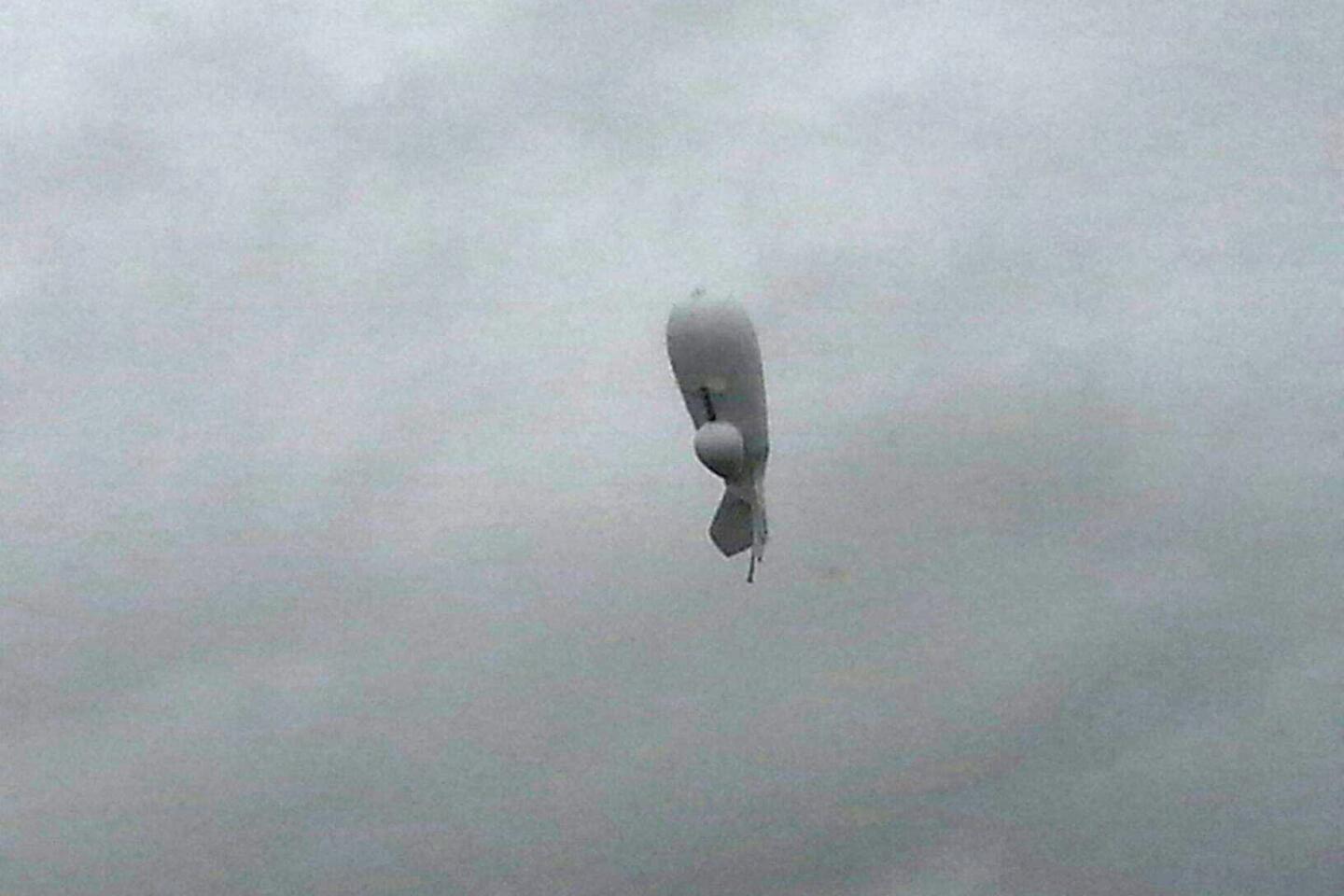Runaway blimp crash-lands after wild chase by F-16s
- Share via
Reporting from Washington — After a wild four-hour jaunt above parts of two states, a runaway military surveillance blimp crash-landed in rural Pennsylvania on Wednesday, ending a bizarre incident that raised concerns -- and many smiles -- across the Northeast.
Two F-16 fighter jets were scrambled from New Jersey to help monitor the giant blimp after it tore loose from a ground mooring at an Army base in northern Maryland and took to the windy skies, according to the Pentagon.
Before it crashed into a clump of trees, the rogue blimp had caused havoc in central Pennsylvania. PPL Electric Utilities said 20,000 people lost power after the airship’s tether, a 6,700-foot-long cable that dangled below it, struck power lines as it floated by.
Officials worried that the blimp could drag its tether over a city or a power plant, or collide with an aircraft. But it steadily deflated as it rode the winds and was not shot down by the F-16s.
“It came down quite naturally as it began to lose helium,” said Michael Kucharek, a North American Aerospace Defense Command spokesman. “We’re hearing no reports of injuries. So we’re grateful. It could have been a lot worse.”
The blimp’s tail detached near the end of its 150-mile journey and was found a quarter-mile away from the crash site in Moreland Township, according to NORAD.
Local and state law enforcement officers were on scene and a military recovery team from Aberdeen Proving Grounds in Maryland, where the blimp broke loose, was on its way, officials said.
Pennsylvania state police cordoned off the crash site to make sure none of the blimp’s secret high-tech radar and electronics were stolen, according to a Homeland Security official, who wasn’t authorized to speak on the matter.
Several federal agencies, including the Federal Aviation Administration, the Federal Emergency Management Agency and the Transportation Department, were involved in monitoring the wayward blimp.
The Philadelphia operations center for FEMA, which responds to emergencies in the mid-Atlantic region, helped coordinate efforts to track the blimp by state and local authorities in Pennsylvania.
At midafternoon, the rogue blimp was reported at about 16,000 feet and slowly descending near the small town of Bloomsburg, in central Pennsylvania, officials said.
Earlier, the FAA was working with the Pentagon’s Northern Command and North American Aerospace Defense Command “to ensure air traffic safety,” a military spokesman said.
“We are safely separating it from other air traffic,” FAA spokeswoman Laura J. Brown said in a statement.
NEWSLETTER: Get the day’s top headlines from Times Editor Davan Maharaj >>
Officials urged the public to report any sightings of the 243-foot-long helium-filled blimp, which has no remote controls, and to avoid any contact with the tether and mooring it is dragging along.
“We advise if you’re in the local area and you see it, don’t go near it and contact your local law enforcement,” said Lt. Joe Nawrocki, a Northern Command/NORAD spokesman said in a phone interview from Colorado Springs, Colo.
Officials said the blimp, which is used to conduct military surveillance over the East Coast, broke loose from a ground station about 12:20 p.m. on a windy, rainy day.
The F-16s were scrambled later from an Air National Guard base in Atlantic City, N.J.
Officials could not explain how the blimp, called the JLENS, or Joint Land Attack Cruise Missile Defense Elevated Netted Sensor System, broke away.
The 7,000-pound airship normally is anchored to the ground by 1 1/8-inch-thick Kevlar tethers, which also hold wiring for electricity. A ground crew of about 130 is needed to operate a pair of blimps around the clock.
The JLENS was designed to help provide the Pentagon with an early warning if the United States is attacked with cruise missiles, drones or other low-flying weapons. The blimp system is manufactured by Raytheon Co., based in Waltham, Mass.
The JLENS has been on a trial run at Aberdeen, an Army installation about 60 miles northeast of Washington, in recent months. The system is supposed to help protect the capital area and a surrounding portion of the Eastern Seaboard as it flies at 10,000 feet.
The U.S. has poured about $2.7 billion over the years into the problem-plagued JLENS program, which was the subject of a Los Angeles Times investigation.
Follow me @wjhenn on Twitter.
ALSO:
How the South undoes New York’s efforts to regulate guns
Paul Ryan poised to become House speaker after winning internal GOP vote
Deputy fired for throwing student from her desk, even though ‘she started this,’ sheriff says
More to Read
Sign up for Essential California
The most important California stories and recommendations in your inbox every morning.
You may occasionally receive promotional content from the Los Angeles Times.
















